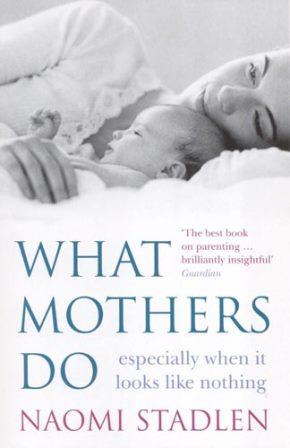
After spending a day at home with my eleven month old son, it’s very easy to look around me and wonder what I’ve achieved.
So I’ve tidied away the toys that made the living room look like a branch of the Early Learning Centre, cleaned on, around and under the high chair for the third time in one day, cooked several meals for myself and a small person…but what have I really achieved? Surely nothing, since all those chores will need doing again tomorrow – and the next day, and the day after that… It’s when I’m starting to despair about how paltry and pointless my life is as a stay-at-home-mum that I remember a lovely book I was given to see me off on my maternity leave: ‘What Mothers Do’ by Naomi Stadlen.
What’s it about?
Stadlen suggests many mothers who spend all day looking after a baby or young child feel they have ‘done nothing’. In this book she sets out to explore the state of modern day mothering and show just how much mothers do, ‘especially when it looks like nothing’. Specifically, the blurb claims that this book will reassure mothers who feel tired all the time, short-tempered with their partner, that no-one understands what they do all day and that nothing prepared them for motherhood.
Stadlen is a psychotherapist and mother-of-three who has run a weekly discussion group for mothers for the past twelve years. Her stated aim is to describe what mothers do, not prescribe what they ought to do. This is not a typical ‘baby book’, full of advice for parents on the usual topics – feeding, sleeping, crying – but an attempt to explain just what it is that mothers do all day and to recognise their value.
What’s it like?
Chapters are loosely organised around topics like tiredness, relationships with partners, comforting and daily routine. This relaxed approach made it easy to read chapters out of order when I had a particular interest. (I read the chapter on tiredness very early on!) The chapter headings are often quotations (‘So tired I could die’) which makes the book feel very honest and almost like a conversation with other mums.

“So tired I could die”
There is an underlying structure to each chapter, creating a sense of discussion moving forward in a logical and easy to follow manner. This is done in a relaxed style – there are no subheadings or rigorous arguments – but each chapter ends with a clear conclusion. Stadlen includes quotations from a variety of mothers and also refers to a range of experts, modern and ancient, (Plato and Aristotle get their say here,) including those she disagrees with. This mix works well and makes the discussions feel well-informed and genuine. Mothers and babies are effectively anonymised by reducing parents to M and F and babies to B and G. Again, this allows a mixture of personal anecdote and professional approach – there is no distraction caused by wondering who on earth calls their child Petunia Winterblossum.
much of what a mother does is nameless and not recognised explicitly by her or by society
Stadlen points out the skills that mothers develop and the skills they help their children to develop, emphasising throughout just how much mothers are doing when it might seem that they are “only” doing a spot of shopping or cuddling their baby. She considers the necessity of developing a new vocabulary that recognises these skills in a positive and respectful way and explores current attitudes towards mothers. She also considers the historical perspective: why do many mothers today seem to find mothering difficult when mothers have been mothering since before humans were human? Her comments on the way society has changed in the last hundred years help to explain this and I felt her ideas and the experiences of the women she quoted meshed with many of my experiences.
Final thoughts
I certainly found it reassuring, although the claim on the back cover that ‘you will find this the most reassuring book you have ever picked up’ is rather grandiose. I have often felt I have ‘done nothing’ all day, although of course what I really mean by that, as Stadlen notes in an early chapter, is that I have done nothing society seems to value or give names to. Many of the chapters return to this idea: that much of what a mother does is nameless and not recognised explicitly by her or by society, potentially leading to a belief that what she does is not valuable.
This book is written with educated, professional, well-travelled women in mind and assumes that motherhood comes as a jolt to such a woman. This does not mean that Stadlen considers motherhood to be a negative event, simply that it changes everything and a previously career minded woman may find this particularly difficult. If you grew up one of eight children, helped bring up the little ones, left school at sixteen and started your own family (as a for instance) then this book will probably not be as relevant to you since motherhood is likely to be experienced as less of a shock.
Finally, if you are a man who wonders what on earth your partner does all day with a small baby and when things will return to ‘normal’, I highly recommend reading this book.